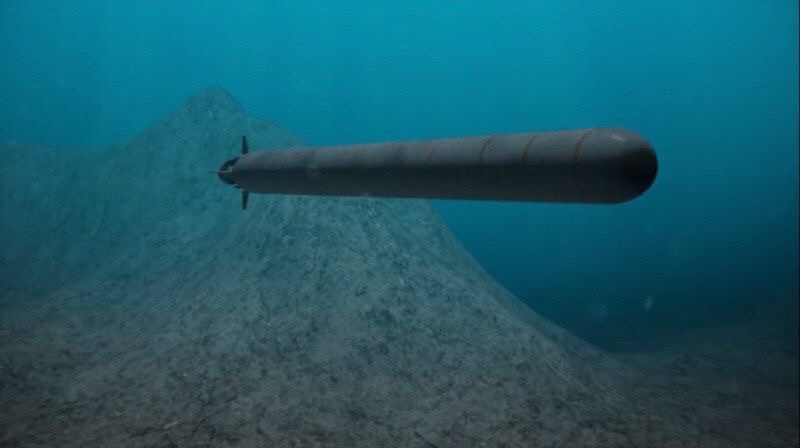 Russia Says It Will Soon Have More Than 30 Nuclear Apocalypse Torpedoes: Report
Russia Says It Will Soon Have More Than 30 Nuclear Apocalypse Torpedoes: Report
Russian state news media is reporting that the country’s armed forces will receive more than thirty, long-range nuclear-tipped super-torpedoes. Named Poseidon, the super-torpedoes will be armed with thermonuclear warheads designed to obliterate coastal cities and other targets and spread lethal radioactive fallout. The fast-moving, nuclear armed torpedo would be difficult for U.S. and allied forces to stop, and failure to do so would guarantee the deaths of millions.
Poseidon, originally known as Kanyon or Status 6, was originally revealed in in November 2015 when the weapon’s name and a picture were “accidentally” leaked by Russian state television. The leaked information included a range of 6,200 miles, maximum submergence depth of 3,280 feet and a top speed of 56 knots, which works out to 64 miles an hour on land. The name was changed to Poseidon in 2018, and full scale tests are anticipated to begin this year.
Now, TASS media agency is reporting Moscow will procure 32 Poseidon torpedoes, with sixteen based with the country’s Northern Fleet and sixteen based with the country’s Pacific Fleet. Poseidon missiles based with the Northern Fleet could attack targets in Europe, Canada, and the East Coast of the United States, while Pacific Fleet torpedoes could attack Japan, China, Canada and the West Coast of the U.S.
Poseidon will be the largest torpedo designed by any country, with a diameter of 6.5 feet and a length of 65 feet. It will be nuclear powered, giving it the ability to cross the Atlantic and Pacific Oceans solo. It will be inertially guided, allowing it to avoid the need to surface to get a GPS fix on its position. The warhead was previously claimed to be up to 200 megatons but is now reported at 2 megatons. While not as horribly over the top as a 200 megaton weapon, it’s still worth keeping in mind that 2 megatons = 2,000 kilotons—and the Hiroshima nuclear blast was a mere 16 kilotons.
Poseidon is designed to be carried two at a time by a mothership submarine, including the submarines Sarov and Khabarovsk, then launched at their targets at extreme ranges. Poseidon won’t be difficult to detect but it will be hard to stop—traveling at 56 knots it will outrun both the U.S. Navy’s nuclear-powered attack submarines and Mk. 48 heavyweight guided torpedoes. Here’s a video made by Russia’s Ministry of Defense to help explain how Poseidon might affect you.
Thirty two Poseidon missiles with multi-megaton warheads would cause terrible damage to U.S. and NATO cities. An attack on San Francisco, with the torpedo detonating under the Golden Gate Bridge, would kill or injure more than half a million people and spread airborne radiation as far north as Nevada. A Poseidon torpedo swimming up to the Statue of Liberty in New York harbor would kill half a million outright and injure another two million, contaminating territory as far north as Portland, Maine. Such devastating attacks would be repeated over and over again against coastal targets on both coasts and abroad, generating tsunamis full of radioactive debris designed to spread fallout inland. The exact target list would only be known to Moscow, but two places for sure on the list are Kitsap, Washington and Kings Bay, Georgia, the east and west coast bases that support America’s ballistic missile submarines. Without those bases in a nuclear war those submarines could not return to reload their missile tubes.
As frightening as Poseidon is, the new weapon is worthless as a first-strike weapon. Poseidon will not suddenly kill you in your sleep with zero warning. Unlike intercontinental ballistic missiles that can reach the United States in minutes, Poseidon needs hours or even days to reach its targets. That’s plenty of time to retaliate and destroy Russia. Instead, Poseidon is designed as a second-strike weapon, dissuading enemies from attacking Russia lest it unleash the nuclear apocalypse torpedo. As long as nuclear war doesn’t break out Poseidon stays in the nuclear bullpen.
Why is Russia developing such a nightmarish weapon? Moscow is worried that America’s ballistic missile defenses, as small as they are, could eventually be scaled up to protect it from Russian missile attacks. Expanding U.S. defenses to do so would involve a thousand-fold increase in interceptors, but it is a theoretical possibility—at least from Russia’s perspective. Unless Russia has retaliatory weapons that can sneak around those defenses, Russia’s nuclear deterrent could be rendered worthless.
Can anyone—or anything stop Poseidon’s deployment? Yes. Poseidon is expensive, and Russia’s economy is smaller than that of Texas or California’s while maintaining a huge arsenal of conventional or nuclear weapons. Poseidon could become unaffordable, or Russia could decide to fund other types of weapons. An arms control agreement between the United States and Russia could outlaw such weapons, but such agreements generally rely on good relations, and the United States would need to give up something on its end—for a weapon that might end up being cancelled anyway. The entire point of developing Poseidon may be to use as a bargaining chip.
Poseidon is the first new type of nuclear weapon in decades. As numbed as the general public is to threat of nuclear war, Poseidon with its radioactive tsunamis feels like a fresh outrage. Will Russia eventually field this new terror weapon? We’ll just have to see.
No comments:
Post a Comment